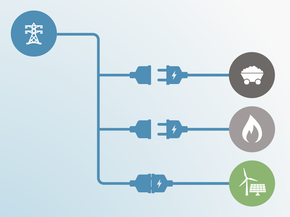Country summary
Overview
China’s CO2 emissions rose in 2017, suggesting that it is still too early to say if CO2 emissions have peaked. China’s Paris Agreement commitment requires its CO2 emissions to peak by 2030. Declining emissions between 2014 and 2016 led some researchers, including the Climate Action Tracker, to postulate that the peak may have been reached. However, 2017 saw coal use increase for the first time in three years (although it remained below its 2013 peak), which, together with rising demand for oil and gas, drove CO2 emissions above 2014 levels, the previous record high.
The question is, what comes next? If the recent overall downward trend in China’s coal use continues for the next few years, it is plausible that overall CO2 emissions peaked in 2017. In this case, total Chinese GHG emissions would be likely to only show a very slight increase in the period between 2015–2030 and will essentially plateau at close to 12.0 GtCO2e/year. If, however, coal consumption does not continue to decline, and instead stalls at today’s levels, and no additional policies are introduced to limit other, non-CO2 gases, China’s total GHG emissions could continue to rise until at least 2030.
With current policies, China is on track to meet or exceed its 2030 Nationally Determined Contribution (NDC) under the Paris Agreement. The CAT rates China’s NDC “Highly insufficient,” as it is not ambitious enough to limit warming to below 2°C, let alone limiting it to 1.5°C as required under the Paris Agreement, unless other countries make much deeper reductions and comparably greater effort.
Despite the increase in 2017 emissions, China’s top climate official, Xie Zhenhua, has announced that China met its 2020 carbon intensity target in 2017, three years ahead of schedule. CAT analysis based on official Chinese GDP data confirms this. If China maintains this intensity level (or lowers it) over the next three years, it will achieve the intensity element of its 2020 pledge. Under current policies, China is also likely to achieve its (more stringent) 2020 target to limit fossil fuels, but neither of these targets are compatible with limiting global temperature increase to 1.5°C.
On 3 September 2016, China ratified the Paris Agreement, and it has policies in place to reach its NDC goals. These policies are currently centred around the targets set in its NDC, which include a commitment to peak CO2 emissions by 2030 at the latest, lower the carbon intensity of GDP by 60%–65% below 2005 levels by 2030, increase the share of non-fossil energy carriers of the total primary energy supply to around 20% by that time, and increase its forest stock volume by 4.5 billion cubic metres, compared to 2005 levels.
China’s NDC’s targets, if reached, would result in GHG emission levels of roughly 12.7–13.8 GtCO2e in 2030, a 64%–70% reduction of emissions intensity below 2005 levels (using the latest projections on GDP development (IEA, 2017a)). The NDC carbon intensity targets on their own would lead to 2030 emission levels of 13.7–15.6 GtCO2e. As the intensity targets are likely to be reached automatically if the non-fossil targets are achieved, and our rating is based on achieving all NDC targets, we do not address the intensity targets separately here. (China’s intensity target on its own would result in a “Critically insufficient” rating.)
However, this range also implies that China’s NDC and its national actions are not yet consistent with limiting warming to below 2°C, let alone 1.5°C unless other countries make much deeper reductions and comparably greater effort than China. We therefore rate the emission levels estimated for 2025 and 2030 resulting from the most ambitious aspects of the NDC as “Highly insufficient.”
Our analysis shows that China will achieve both its 2020 and 2030 pledges. Current policy projections show that emissions in 2030 could lie in the range of 11.7–13.4 GtCO2e, implying that China may well overachieve the target levels implied by its NDC with its current policies, and that under the most optimistic assumptions, its emissions could essentially plateau during the next decade.
China is implementing significant policies to address climate change, most recently aiming to restrict coal consumption, which may well already have peaked, but experienced a slight rebound in 2017, based on recent estimates. China’s 13th Five-Year-Plan stipulates a maximum 58% share of coal in national energy consumption by 2020 (NDRC, 2016). The CAT assesses two scenarios of future developments in coal consumption: a continued coal abatement scenario as well as a stalled coal abatement scenario:
- Under the “continued coal abatement” scenario, where coal consumption decreases at a similar rate as between 2014 and 2016—forming the lower range of the 2030 projections—CO2 emissions would already have plateaued in 2017, and will decrease substantially up to 2030, reaching the NDC peaking target around ten years early.
- In the “stalled coal abatement” scenario, total coal consumption stabilises after the recent decreases and remains constant through the decade 2020–2030 (see 'Current policy projections' for more detail).
However, total GHG emissions are likely to continue increasing until 2030, as China has not yet implemented sufficient policies addressing non-CO2 GHG emissions (CH4, N2O, HFCs etc.), although the rate of increase of total emissions would become near-zero under the most optimistic assumptions of continued coal abatement. As the NDC acknowledges that addressing these gases is important, further policy action may be expected to address non-CO2 emissions as well.
Further analysis
Latest publications
Stay informed
Subscribe to our newsletter






